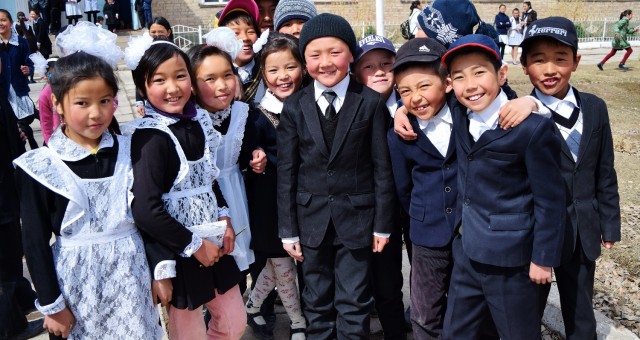
School Hopping in the Kyrgyz Tien-Shan Mountains
This is map of all the districts in Kyrgyzstan. The ones highlighted are the districts I visit frequently for work–At-Bashi, Ak-Talaa and Naryn Districts–all located in Naryn Oblast (province).

Source: “Kyrgyzstan districts numbered” via Wikimedia Commons
Naryn Oblast is famous for its rolling green jailoos–summer pastures–which during the summer months are covered with red poppies and speckled with herders and their yurts. But more on that in a later post! Because right now, I’d like to share a different side of Naryn–a side that’s not on the typical tourist agenda.

To offer some background info, I’m a graduate student in international environmental policy in Kyrgyzstan on a year-long fellowship, and I’m interning with a local NGO on conflict management over natural resources and climate change adaptation projects. One of the projects I’m involved with is a pilot a project that partners with the University of Central Asia (UCA) to introduce low-cost environmental field courses in remote schools in mountain communities of Kyrgyzstan’s Naryn Oblast.
The project is called the Kyrgyz Mountains Environmental Education and Citizen Science (KMEECS). It combines citizen science on the community level, environmental research, and curriculum-linked programming to foster awareness of/and interaction with the local environment. At the same time, it aims at generating locally relevant data on the environment on the theme of either water quality analysis or climate change monitoring (still TBD) in mountain areas of Kyrgyzstan.
If you’d like to know more about the project, please visit Aline Rosset’s blog post. She wrote the project proposal and keeps a detailed blog for the project funder, OCSDNet, and explains in detail what citizen science is, why the focus on Naryn Oblast, and what the expectations for the project are. My contribution to the project will be to make a baseline study about what students currently understand about local environmental challenges, as well as visually documenting the project in the form of photographs and a documentary film.
But that’s enough science talk! I’d like to share some photos of the schools and the kids. In the photo below, the man with the Kyrgyz halo around his head is my colleague, Bilimbek, and he’s introducing our project to a school director and teachers.

Another photo of teachers in a different school: the man in the photo is wearing the Kyrgyz national hat, called a kalpak.

At the entrance of every school are the words Кош Келиӊиздер! This means Welcome! in Kyrgyz.

One thing I love about Naryn is the way that kids dress. According to my Kyrgyz colleague, the traditional Soviet schoolgirl uniform was a black dress with white lace pinafores and collars. Whereas most girls in Bishkek wear mini-skirts (yup, that caught on), many of the schools in Naryn continue to use the traditional Soviet school uniform. The girls look beautiful with their dresses and bows, and the boys sport little man suits.


My colleagues and I visited 30 schools, and 10 of them will eventually be selected for the pilot project. Some nights we stayed in the town of Naryn, but when we visited more remote schools we stayed in At-Bashy Village. The name literally translates to Horse Head Village in Kyrgyz, and in 2008 the town’s main square got it’s very own horse head.

The schools were sometimes a 1.5 hour drive or more apart from one another, so every now and then we’d stop to stretch our legs and enjoy the view.

The schools pretty much all have views like this–lots of open space and mountains, mountains, mountains!

All of the schools were surrounded by a fence and most had really tiny entrance gates that were tough to pass through. At first, I didn’t understand the reason for the tiny gates… but I think this explains it.

Visiting off-the-beaten-path villages isn’t on the typical Naryn tourist agenda, and I’m glad I had the opportunity to experience what everyday life is like in these small mountain communities. One day I’ll do the typical horse trekking to Song Kul Lake and stay in a yurt in some remote alpine valley, but until then–this is the side of Naryn I’ve come to know and appreciate.
I recently produced a short digital story about my experience so far in Kyrgyzstan–feel free to have a look!

I am looking to volunteer in the mountain region. Do you have a school you could recommend that needs help? Thank you.